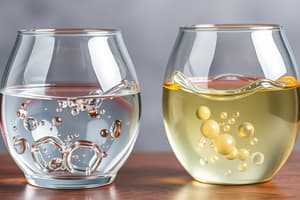Podcast
Questions and Answers
What are the main properties of liquids in contrast to gases and solids?
What are the main properties of liquids in contrast to gases and solids?
- Easily compressed
- Definite volume (correct)
- High density compared to gases (correct)
- Indefinite shape and assumes the shape of their container (correct)
What are the main properties of solids in contrast to liquids and gases?
What are the main properties of solids in contrast to liquids and gases?
- Easily compressed
- Higher density compared to gases (correct)
- Definite volume (correct)
- Definite shape (correct)
What factors cause changes between the solid and liquid state?
What factors cause changes between the solid and liquid state?
Cooling converts a liquid to a solid; heating converts a solid to a liquid.
What factors cause changes between the liquid and gas state?
What factors cause changes between the liquid and gas state?
What happens to physical properties as the strength of intermolecular forces increases?
What happens to physical properties as the strength of intermolecular forces increases?
What intermolecular force is present in all molecules and atoms?
What intermolecular force is present in all molecules and atoms?
The dispersion force increases with increasing molar mass.
The dispersion force increases with increasing molar mass.
Where do dipole-dipole forces exist?
Where do dipole-dipole forces exist?
Which atoms bond with hydrogen in hydrogen bonding?
Which atoms bond with hydrogen in hydrogen bonding?
What is the strongest intermolecular force?
What is the strongest intermolecular force?
When does the ion-dipole force occur?
When does the ion-dipole force occur?
What is surface tension of a liquid?
What is surface tension of a liquid?
What is viscosity?
What is viscosity?
What is capillary action?
What is capillary action?
What are cohesive forces versus adhesive forces?
What are cohesive forces versus adhesive forces?
What is vaporization?
What is vaporization?
What is the transition from gas to liquid called?
What is the transition from gas to liquid called?
What are volatile and non-volatile liquids?
What are volatile and non-volatile liquids?
Is vaporization endothermic?
Is vaporization endothermic?
Is condensation endothermic?
Is condensation endothermic?
What is the heat of vaporization?
What is the heat of vaporization?
What is dynamic equilibrium?
What is dynamic equilibrium?
What is vapor pressure?
What is vapor pressure?
What is the boiling point of a liquid?
What is the boiling point of a liquid?
What is the normal boiling point of a liquid?
What is the normal boiling point of a liquid?
What is sublimation?
What is sublimation?
What is a phase diagram?
What is a phase diagram?
What is the triple point on a phase diagram?
What is the triple point on a phase diagram?
What is the critical point on a phase diagram?
What is the critical point on a phase diagram?
What is the fusion curve, sublimation curve, and vaporization curve?
What is the fusion curve, sublimation curve, and vaporization curve?
What are molecular solids?
What are molecular solids?
What are ionic solids?
What are ionic solids?
What are atomic solids?
What are atomic solids?
What are nonbonding atomic solids?
What are nonbonding atomic solids?
What are metallic atomic solids?
What are metallic atomic solids?
What are covalent atomic solids?
What are covalent atomic solids?
What is a solution?
What is a solution?
What is a solvent?
What is a solvent?
What is a solute?
What is a solute?
What is the solubility of a substance?
What is the solubility of a substance?
What is entropy?
What is entropy?
When heat is evolved, the solution process is...
When heat is evolved, the solution process is...
When heat is absorbed, the solution process is...
When heat is absorbed, the solution process is...
What is a saturated solution?
What is a saturated solution?
What is an unsaturated solution?
What is an unsaturated solution?
What is a supersaturated solution?
What is a supersaturated solution?
How does temperature affect the solubility of solids and gases?
How does temperature affect the solubility of solids and gases?
What is osmosis?
What is osmosis?
Flashcards are hidden until you start studying
Study Notes
Properties of States of Matter
- Liquids have a definite volume and higher density compared to gases; they take the shape of their container and are not easily compressed.
- Solids possess a definite shape and volume, are dense, resistant to compression, and can be classified as crystalline (ordered) or amorphous (disordered).
State Changes
- A liquid transforms into a solid through cooling, while heating converts a solid into a liquid.
- The interconversion between liquid and gas states is influenced by pressure increases or cooling for gas to liquid, and heating for liquid to gas.
Intermolecular Forces
- Increasing intermolecular forces raise melting point, boiling point, viscosity, and surface tension, while lowering vapor pressure.
- Dispersion forces exist in all molecules and atoms, with strength increasing alongside molar mass.
- Dipole-dipole forces occur in polar molecules, while hydrogen bonds form between hydrogen and F, O, or N.
Phase Transition Processes
- Ion-dipole forces arise when ionic compounds mix with polar compounds, representing the strongest intermolecular force.
- Surface tension is the energy needed to increase a liquid's surface area, while viscosity measures a liquid's resistance to flow.
- Capillary action refers to a liquid's ability to rise against gravity in a narrow tube.
Vaporization and Condensation
- Vaporization is an endothermic process where thermal energy allows liquid to convert to gas.
- Condensation, an exothermic process, occurs when gas transitions to a liquid, releasing heat.
- Heat of vaporization represents the heat required to vaporize one mole of liquid, increasing with stronger intermolecular forces.
Equilibrium and Phase Diagrams
- Dynamic equilibrium refers to equal rates of vaporization and condensation.
- Vapor pressure is the pressure exerted by a gas in equilibrium with its liquid.
- The boiling point is when a liquid's vapor pressure matches the external pressure; normal boiling point occurs at 1 atm.
Sublimation and Phase Diagrams
- Sublimation is the direct transition from solid to gas.
- A phase diagram displays the states of matter versus pressure, with key points like the triple point (where all states are stable) and the critical point (above which a supercritical fluid exists).
- Fusion, sublimation, and vaporization curves indicate the transitions between solid, gas, and liquid phases.
Types of Solids
- Molecular solids consist of molecules and have lower melting points.
- Ionic solids are made of ions, exhibiting high melting points.
- Atomic solids consist of individual atoms and can be further categorized into nonbonding, metallic, and covalent atomic solids based on bonding types.
Solutions and Solubility
- Solutions are homogeneous mixtures comprised of a solvent (majority component) and solute (minority component).
- Solubility defines how much substance dissolves in a given solvent; solid solubility generally increases with temperature, whereas gas solubility decreases.
- The solution process can be exothermic (heat evolved) or endothermic (heat absorbed), influencing solute dynamic equilibria.
Saturation States
- A saturated solution contains solute in dynamic equilibrium with solid solute, while an unsaturated solution holds less than the equilibrium amount.
- A supersaturated solution contains more solute than equilibrium allows, demonstrating unique chemical behavior.
Osmosis
- Osmosis describes solvent movement from lower to higher solute concentration solutions, highlighting the natural tendency for mixtures to equilibrate.
Studying That Suits You
Use AI to generate personalized quizzes and flashcards to suit your learning preferences.




